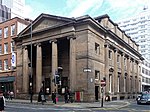Estate Exchange
Grade II* listed buildings in ManchesterGrade II* listed office buildingsGreater Manchester building and structure stubsOffice buildings completed in 1858

The Estate Exchange at 46 Fountain Street, Manchester, England, is a Victorian office block by Thomas Worthington. It was built as Overseers' and Churchwardens' Offices in 1852, with the top two floors being added in 1858. It is a Grade II* listed building as of 3 October 1974.The building is in an "Italian palazzo style, of red brick with sandstone dressings (and a) slate roof". Hartwell considers it the best building on Fountain Street: "Each floor is treated differently and there is a range of oeil-de-boeuf windows in stone frames in the attic".
Excerpt from the Wikipedia article Estate Exchange (License: CC BY-SA 3.0, Authors, Images).Estate Exchange
Fountain Street, Manchester City Centre
Geographical coordinates (GPS) Address Nearby Places Show on map
Geographical coordinates (GPS)
| Latitude | Longitude |
|---|---|
| N 53.4806 ° | E -2.2411 ° |
Address
Fountain Street 46
M2 2BQ Manchester, City Centre
England, United Kingdom
Open on Google Maps










